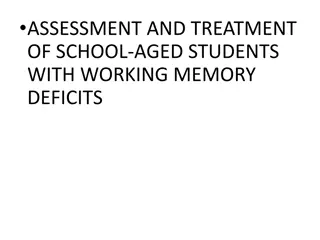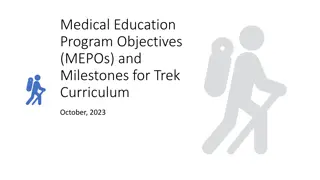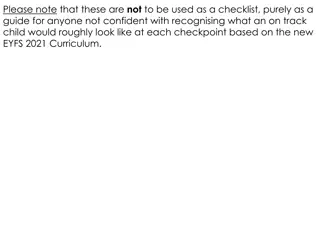Development Milestones in Children Aged 4-6
Children aged 4-6 experience significant growth and development in various aspects including height, weight, posture, body shape, teeth, motor skills, and hand preferences. They exhibit noticeable changes in height and weight, improved posture and body shape, the emergence of permanent teeth, and advancements in motor skills. Additionally, thumb sucking may still be present, and they develop both gross and fine motor skills during this period.
Download Presentation

Please find below an Image/Link to download the presentation.
The content on the website is provided AS IS for your information and personal use only. It may not be sold, licensed, or shared on other websites without obtaining consent from the author.If you encounter any issues during the download, it is possible that the publisher has removed the file from their server.
You are allowed to download the files provided on this website for personal or commercial use, subject to the condition that they are used lawfully. All files are the property of their respective owners.
The content on the website is provided AS IS for your information and personal use only. It may not be sold, licensed, or shared on other websites without obtaining consent from the author.
E N D
Presentation Transcript
Main Idea Children from 4-6 grow and develop in many areas: Height & weight Posture & body shape Teeth Motor Skills Hand preference
Height & Weight Growth slightly slower than from 1-3. Boys are usually slightly taller & heavier during this period. They average a height gain of 5 inches and an average of 10 lbs. in weight from ages 4-6. Average boy at 6 is 45.5 tall and weighs 46 lbs. Girls average 45.25 tall and weigh 44.5 lbs.
Posture & Body Shape Between 4 & 7 posture changes noticeably Bodies are straighter & slimmer Protruding tummy flattens Hold shoulders, back & upper body erect Chest which was rounded, broadens and flattens Legs lengthen rapidly and neck gets longer
Toddlers Running http://www.youtube.com/watch?v=lXZGEu4fIAQ&fe ature=em-share_video_user
4-6 Year Olds Running http://www.youtube.com/watch?v=v6GmSemtb5 s&feature=em-share_video_user
Teeth Permanent teeth begin to appear around age 6. Six year molars are the first to appear Two molars on top and two on the bottom Molars are the anchors for the other teeth Primary teeth are lost in the same order they come in.
Thumbsucking 4-6 year olds still may suck their thumbs to comfort themselves or handle stress. Usually grow out of it. Try to ignore. After their fifth birthday may cause changes in the roof of the mouth and the way teeth line up.
Gross (Large) Motor Skills Many must be taught. Very energetic and favorite things are usually physical. Speed and coordination improves each year and with practice. Provide lots of opportunities to improve.
Fine Motor Skills Improved Dexterity ( Dexterity (ease and skill in physical activity) This improved dexterity allows them to do physical activities more easily. Starting to use their hands & fingers skillfully. Improved hand-eye-coordination helps them to do skills they already had better.
What can 4s do? Fine Motor Skills Fine Motor Skills Dress & undress self Gross Motor Skills Gross Motor Skills Hop on one foot Cut on a line with scissors Throw a ball overhand Copy a circle & a cross Alternates feet walking up & down stairs Walks backward easily Lace shoes but not tie them
What can 5s do? Fine Motor Fine Motor Draws a person with head, body, arms, & legs Gross Motor Gross Motor Can turn somersaults Prints some letters Skips with alternating feet Buttons clothing Balances on each foot for a short period. Can copy a triangle & square Uses spoon & fork to eat but still uses fingers for some food
What can 6s do? Fine Fine Motor Skills Motor Skills Cuts, pastes, & colors skillfully Gross Motor Skills Gross Motor Skills Ride a two-wheeler with training wheels Jumps rope Writes entire words Ties shoelaces Throws & catches a ball with more ease and accuracy (this also requires fine motor skills & hand-eye-coordination)
Hand Preference Some children show a preference after age 2 Others continue to switch off until about the second have of year 5. 85% prefer right hand Few are ambidextrous ambidextrous (ability to use both hands with equal skill).
What to believe about hand preference. Some believe heredity is the source Others think it is what hand the parents place things in during the early years. Some research links it to the areas of the brain controlling motor skills or language Whatever the cause ..no reason to influence a child using one hand over the other.
On the left side ..answer the following: 1. What is the average gain in height for a boy from age four to age six? 2. What are the first teeth that children get that are not replacements for their baby teeth? 3. Why can it become a problem if a child continues to suck a thumb after his or her fifth birthday?
And the answers are. 1. Average 5 inch height gain from age 4-6 2. 6 year molars or first molars 3. Can cause changes in the shape of the roof of the mouth or in the way teeth line up





















